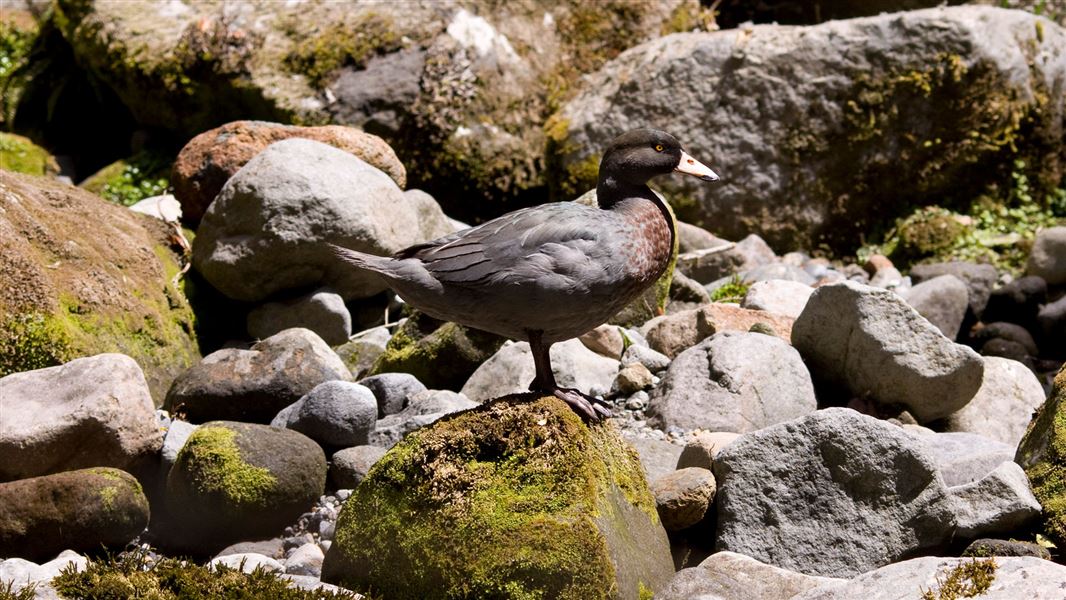Archived content: This media release was accurate on the date of publication.
Date: 13 August 2021
There are now 863 whio breeding pairs living in eight protected sites across the country – 565 more pairs since 2011 and an increase of 190%.
DOC Director General Lou Sanson says the excellent survey results reinforce the decision of DOC and Genesis to renew their Whio Forever partnership.
“With ongoing support from Genesis, DOC’s goal is to take whio from ‘threatened’ status to ‘at-risk’ and grow New Zealand’s national whio population from less than 3,000 to more than 5,000 birds.”
The majority of the funding from Genesis goes directly towards predator control. Over the last decade, more than 5,000 traps have been laid by hundreds of DOC staff and volunteers at key sites across the country. This means almost 1,700 kilometres of river is now protected, providing secure sites where whio can thrive.
Genesis’ funding of Whio Forever has also helped foster and inspire contributions from iwi, communities and interest groups to undertake nationwide predator control to protect and grow whio populations.
Genesis Chief Operating Officer Nigel Clark says the company is proud to be part of a partnership that is achieving such meaningful results.
“It takes a community to raise a whio. The wins we’re celebrating today are driven not only by the partnership between DOC and Genesis, but also through the hard work of many individual trapping enthusiasts, privately run trusts and businesses that hold whio breeding pairs, hatch whio eggs and raise their chicks.”
Lou Sanson says the whio population has continued to climb despite the challenges of a mega-mast (heavy seeding) and severe flooding, along with predator control delays due to bad weather and COVID-19.
“Our growing whio population demonstrates the resilience of the species. But its survival is still very much dependent on our conservation efforts, which demand time, money and hard work. The gains we’ve made over the last decade could easily be lost in a season, so we can’t rest on our laurels. There is still a lot more to do.”
Today, DOC and Genesis renewed their recovery partnership at an event in Tūrangi, joined by iwi, community leaders and volunteers. A commemorative predator trap was also laid to mark the occasion.
“DOC and Genesis are in this for the long haul. With support from the wider community and Iwi, we can ensure the survival of one of our most precious native birds,” Lou Sanson says.
Background Information on whio
- The whio is a threatened species of native duck that is only found in New Zealand’s fast flowing waters. Featured on New Zealand’s $10 note and with an estimated nationwide population of less than 3000 birds, whio are rarer than some species of kiwi.
- Whio are important indicators of ecosystem health – they only exist where there is quality fresh water and an abundance of life.
Whio Forever
- Genesis has a strong historic association with whio through the Tongariro Power Scheme. In 2010 this association grew through the establishment of Whio Awareness Month (March).
- The Genesis and the Department of Conservation (DOC) partnership through the Whio Forever Project aims to secure the future of whio in the wild and ensure New Zealanders understand and value whio.
- The support of Genesis and the work of DOC has enabled the Whio Recovery Plan to be implemented.
Conservation issue
- Whio are predated by stoats, ferrets and cats with the largest impact during nesting time when eggs, young and females are vulnerable, and also when females are in moult and can’t fly.
- Extensive trapping can manage these predators. Work in key whio habitats by DOC and Genesis on the Whio Forever Project has already seen an increase in whio numbers.
Whio cannot be moved to predator-free islands like other species because of their reliance on fast-flowing rivers. - Pairs occupy approximately 1km of water – so they need a lot of river to sustain a large population. They fiercely defend their territories, which makes it difficult to put them with other ducks in captivity.
- Whio are susceptible to flood events, which destroy nests, fragment broods and wash away their valued food source.
Contact
For media enquiries contact:
Email: media@doc.govt.nz
